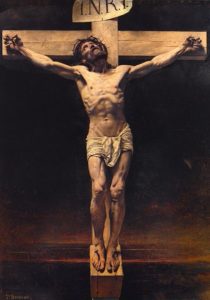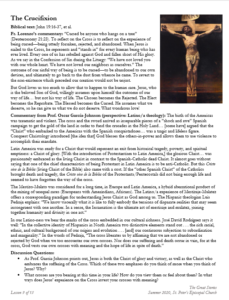
Biblical text: John 19:16-37, et al.
Fr. Lorenzo’s commentary: “Cursed be anyone who hangs on a tree” (Deuteronomy 21:23). To reflect on the Cross is to reflect on the experience of being cursed—being utterly forsaken, rejected, and abandoned. When Jesus is nailed to the Cross, he represents and “stands in” for every human being who has ever lived. Every one of us has rebelled against God and fallen short of His glory. As we say in the Confession of Sin during the Liturgy: “We have not loved you with our whole heart. We have not loved our neighbors as ourselves.” The outcome of our sinful way of being is to be cursed—to be abandoned to our own devices, and ultimately to go back to the dust from whence he came. To revert to the non-existence which preceded our creation would not be unjust.
But God loves us too much to allow that to happen to the human race. Jesus, who is the beloved Son of God, willingly assumes upon himself the outcome of our way of life… but not his way of life. The Chosen becomes the Rejected. The Elect becomes the Reprobate. The Blessed becomes the Cursed. He assumes what we deserve, so he can give us what we do not deserve. What wondrous love!
Commentary from Prof. Oscar García-Johnson (perspective: Latino/a theology): The birth of the Americas was traumatic and violent. The cross and the sword arrived as inseparable pieces of a “shock and awe” Spanish campaign to get the gold of the land in order to fund the crusades in the Holy Land… [some have] argued that the “Christ” who embarked to the Americas with the Spanish conquistadores… was a tragic and lifeless figure. Conquest Christology introduced [the idea that] God blesses the others-in-power and allows them to use violence to accomplish their mandate.
Latin America was ready for a Christ that would represent an exit from historical tragedy, poverty, and spiritual emptiness: a Christ of glory. [With the introduction of Protestantism to Latin America,] the glorious Christ… was passionately embraced as the living Christ in contrast to the Spanish-Catholic dead Christ. It almost goes without saying that one of the chief characteristics of being Protestant in Latin America is to be anti-Catholic. But this Cristo vivo de la Biblia (living Christ of the Bible) also came with a cost. If the “other Spanish Christ” of the Catholics brought death and tragedy, the Cristo vivo de la Biblia of the Protestants/Pentecostals did not bring enough life and seemed to have forgotten the way of the cross.
The Mestizo-Mulato was considered for a long time, in Europe and Latin America, a hybrid aberrational product of the mixing of unequal races (Europeans with Amerindians, Africans). The Latino/a experience of Mestizaje-Mulatez offers a corresponding paradigm for understanding Jesus Christ as God among us. The Hispanic theologian Luis Pedraja explains: “We know viscerally what it is like to fully embody the tensions of disparate realities that may seem incongruent with one another. In a sense, the Incarnation is the ultimate act of mestisaje and mulatez, joining together humanity and divinity in one act.”
In our Latino-ness we bear the marks of the cross embedded in our cultural richness. José David Rodríguez says it well: “In the collective identity of Hispanics in North America two distinctive elements stand out . . . the rich racial, ethnic, and cultural background of our origins and evolution . . . [and] our continuous subjection to subordination and marginality.” In the words of Pedraja, “The cross liberates us by affirming that we are not abandoned or rejected by God when we too encounter our own crosses. Nor does our suffering and death occur in vain, for at the cross, God vests our own crosses with meaning and the hope of life in spite of death.”
Discussion Questions:
- As Prof. Garcia-Johnson points out, Jesus is both the Christ of glory and victory, as well as the Christ who embraces the suffering of the Cross. Which of these two emphases do you think of more when you think of Jesus? Why?
- What crosses are you bearing at this time in your life? How do you view them or feel about them? In what ways does Jesus’ experience on the Cross invest your crosses with meaning?



Comments are closed.